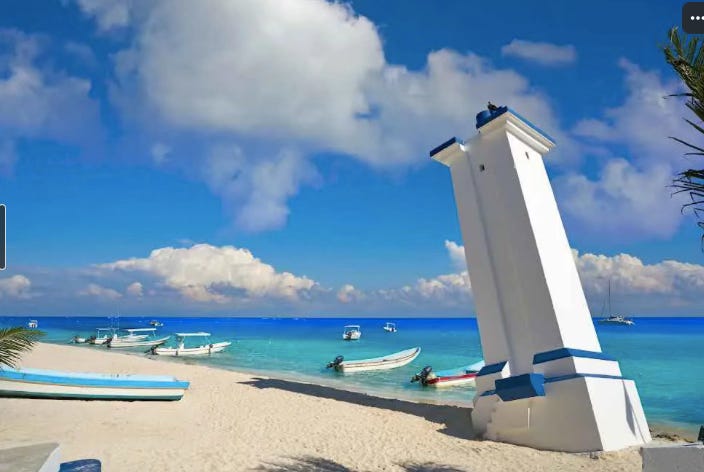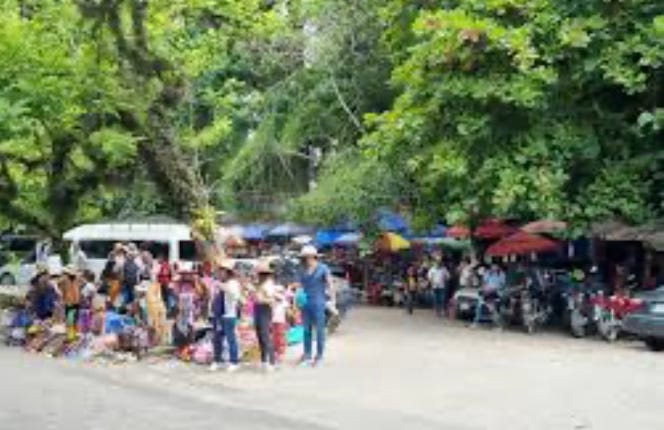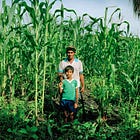Last Roundup in Puerto Morelos
Chapter 37: The bookstore finishes another year as my memoir ends
Hola Amigos! We continue on running the store, ordering more books, and giving trip advice to customers as the year goes on. Day to day, Paul mops the store’s tile floor free of sand and dust every morning while playing opera. Puccini floats out the doors for the entire town square to hear. Paul blames it on his Italian roots. Neto, the local dive master—shop on the corner—stops by to chat, and every other week or so brings a few beers over on Friday night after closing. Miguel, the jewelry maker and his mom next door, are sweet people, long time PM residents. Miguel is a true artist and paints beautiful Maya glyphs and symbols on his jewelry. The other Miguel has a coffee shop two doors down, and that comes in handy. Pepe’s two loopy Weimaraners flop on the square across from the bookstore, feet in the air, the only life other than fellow shopkeepers we’re likely to see until 11 a.m. or so. Semana Santa and Easter come and go as do the tourists, and soon thereafter we’re departing for our trip north, away from Muerto Morelos, a nickname that sticks through the summer months when there’s not a soul anywhere to be found.
The bookstore prospered, tourists came and went, and the season was winding down. Our big plans were to travel to Palenque. I’d fallen in love with pyramids, and after seeing Chichen Itza, Cobá, Tulum and Ek Balam, Palenque beckoned.
After reading Forest of Kings by Linda Schele and David Freidel, archeologists, artists (Schele) and Maya scholars, Paleneque consumed my imagination. To Schele, this pyramid site topped the list of most sacred.
The Lacandon Maya still lived there, supposedly the last link to the ancient Maya hierarchy. During the conquest, Hernando Cortés’ strategy had been to destroy all lineage to rulers, priests, and aristocracy. As Robert Bruce wrote in The Last Lords of Palenque, “The great teachers and leaders were murdered, the books burned, the schools and temples razed . . . (leaving) the people confused, leaderless and enslaved.”
Everywhere else in Mexico but Chiapas, this annihilation occurred. Near Palenque, some Maya escaped to the forests, avoiding extermination. Approximately 400 Lacadron live in Chiapas today, a direct link to the ancient rulers and priests of Palenque.
Northward bound
As winter turned to spring and Easter arrived, we prepared for our journey back to the US. We drove south through Chetumal, the capital of Quintana Roo, then veered west towards Escarcega. Within one hundred miles after turning inland and away from the coast, an opaque haze appeared. This smokey residue accompanied us for close to a thousand miles of our journey.
It was spring and the Maya had begun an age-old ritual: slash and burn agriculture. Bruce wrote, again in The Last Lords of Palenque, “The Lacondon jungle, one of the world’s richest rain forests, grows on some of the world’s poorest soil, most of which consists of a few inches of topsoil covered by a few more inches of extremely rich leaf mold. After the Maya cut trees and clear them away, they plant corn, beans and squash. By the second year of cultivation, the soil is near exhaustion.”
Changing times for agriculture
In days gone by, they moved on and cleared more virgin jungle by slashing and burning, Bruce wrote, as there was still room to spare. But during the Mexican Revolution, “Thousands upon thousands of homesteaders moved into the area to practice a subsistence economy based on slash and burn agriculture. Each family cleared an area of several thousand square meters, and burned a fortune in fine tropical hardwoods in the process.”
Continuing to this day, many Maya burn off their maize fields so they can plant anew. Road signs request that no fires be lit, but cultural habits apparently die hard as we observed small fires in fields for miles and miles as we drove.
Hotel Chan-Ka, our oasis
On arriving in Palenque, we chose Hotel Chan-Ka, a group of cottages on the Chacamax River. The cottages are made of river rocks, soft gray in color and beautifully smooth after who knew how many millennium of repetitiously being washed by water.
Flora reminiscent of Hawaii’s tropics abounded. A dense, verdant green of heliconia, red and pink ginger, and birds of paradise made up the hotel’s exterior gardens. I felt a sense of peace come over me as we unpacked the car and brought our belongings to the expansive porch of our cabin. Huge limbs of ancient trees held up the roof; small river rocks were cemented into the floor design—simple and naturally elegant.
Our cabin sat directly on the river. As Paul unlocked the mahogany door, a light rain began to fall, a momentary phenomenon for April. I felt washed clean after driving through the smoky haze we’d experienced all day along the highway.
After quickly unpacking we left for the pyramid site. It closed at sunset and we still had an hour of daylight. The drive was short as the hotel was only two kilometers away.
The road hugged the river and giant trees, species I’d not yet seen, were scattered in the adjacent fields. Supposedly at one time this had all been dense forest, but as tropical hardwoods became scarce, the larger trees had been cut and sold. Still, a few graced Palenque’s perimeter and I surveyed them as we passed by. Slowly we ascended the road to the pyramids.
On arrival, the atmosphere at the site was unlike anything I’d seen at pyramids in northern Yucatán. Here at Palenque, the Lacondon retained free range of the area and the result was like an open-air market. They’d lobbied for this advantage and won, claiming it was in fact their land.
Inside and outside the entryway and spreading into the parking lot, Maya blankets covered the ground, displaying bright shirts and shorts, colorful bows and arrows, wooden plaques, stone carvings. The musky scent of copal, a Maya incense, burned everywhere, leaving a light, cloudy haze in its wake.
The Lacandon Maya
The Lacondon are beautiful. Their skin is smooth and taut and tan in color. They have high cheekbones, dark, brilliant eyes, and they emitted an aura I can barely describe.
To me, it felt like they were not there in spirit. Their bodies existed, their molecules took up space, but it was as if they had dreamed these bodies and I was sleepwalking in their dream.
They completely disregarded my existence. It was an eerie feeling but it did not make me uncomfortable—I had stepped into their world. They also emanated a feeling of sadness. Bruce, too, in The Last Lords of Palenque, found it a challenge to describe the Lacandon. From a cool and proper distance, he described their watchfulness as, “Poised, stemming for the desire to find their correct place in the universe, in order to live in the greatest possible peace and harmony. This came out in a total ease of their appearance and in their language.”
Inside the pyramid site, the first view I had was of a stand of massive la Ceiba trees, the Maya tree of life. The trees put our purple flowers, then seed pods, with white, fluffy cotton. I’d never seen a tree like this in bloom before and it was stately, with large, straight limbs extending out, as if it could hold up the world.
From this view, surrounded by Ceibas, I looked straight up at the Temple of Inscriptions. Directly across from it stood the Palace, a three story tower, Asian in style. In the background I heard what sounded like lions roaring.
“Paul, do you hear that noise?”
“Howler monkeys. In the tall trees beyond the Temple of Inscriptions.”
I looked up at the forest of thousand year old trees behind the pyramid that housed Pakal’s tomb, listened attentively to the barking roar of monkeys in the background, felt the damp humidity of Chiapas as it engulfed my very being, and I realized this mysterious land of contrasts—pyramids, beaches, jungles and colonial cities—now lived in me.
THE END
Thank you, thank you dear reader, for joining me on my trip to Mexico through all the tense moments and border crossings and eminent domain struggles, but also taking part in the friendships we made, our pyramid adventures and road trips, bookstore fun and madness, and viewing the sweeping landscapes of the country we love through my eyes. There’ll be more stories about our journeys but this ends my memoir, Where the Sky is Born: Living in the Land of the Maya. Previous chapters can be found in the menu up top and also interspersed throughout my site. If you’d like a copy of the paperback or the Kindle version, available at Amazon. The link is here: Where the Sky is Born
And if you’re interested in supporting independent journalism and writing, please consider a paid subscription to Mexico Soul. This is a free newsletter. I don’t paywall any of my posts, but you can choose to pay if you like what I deliver. It would mean the world to me and will keep you up to date on my posts and chapters from Where the Sky is Born—how we bought land and built a house in a small fishing village on the Mexico Caribbean coast. Not to mention a bookstore, too! All for $5/monthly or $50 per year.
If you enjoyed this article, please remember to hit the heart button to like it.
MY BACKSTORY—Puerto Morelos sits 100 miles from four major pyramid sites: Chichen Itza, Coba, Tulum and Ek Balam. Living in close proximity to this Maya wonderland made it easy to pyramid hop on our days off from Alma Libre Libros, the bookstore we founded in 1997. Owning a bookstore made it easy to order every possible book I could find on the Maya and their culture, the pyramids and the archeologists who dug at these sites and the scholars who wrote about them. I became a self-taught Mayaphile and eventually website publishers, Mexican newspapers and magazines, even guidebooks asked me to write for them about the Maya and Mexico. I’m still enthralled by the culture and history and glad there’s always new news emerging for me to report on right here on Mexico Soul.















Another great descriptive chapter, Jeanine. I'll never make it to that place, but I can appreciate what beckons in your writing. Write on, amiga.
You’re such a fantastic writer. Love that I feel like I’m right there with you. I’m picking up your memoir on Amazon, so I can read it in its entirety. I know I missed a few chapters along the way. Thanks for sharing Mexico and the Maya with us. ❤️